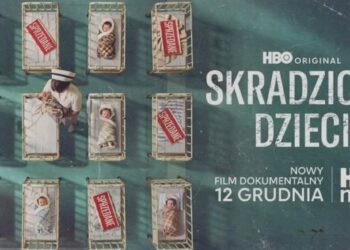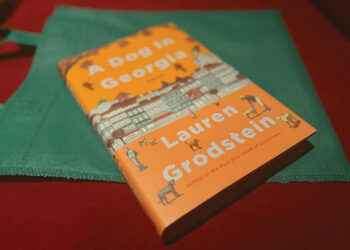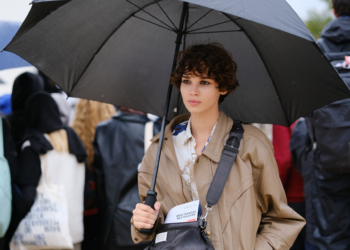The ‘Evrovizion. Crossing Stories and Spaces’ exhibition is an evolving project that travels across Europe, incorporating local contributions to explore and expand the narrative of European identity. When the exhibition arrived in Tbilisi, Georgia, it included significant works by Georgian artists that offered unique perspectives and enriched the broader European discourse. The exposition is being held at the Tbilisi Photography & Multimedia Museum (TPMM) and is open to the public for free until July 21, 2024.
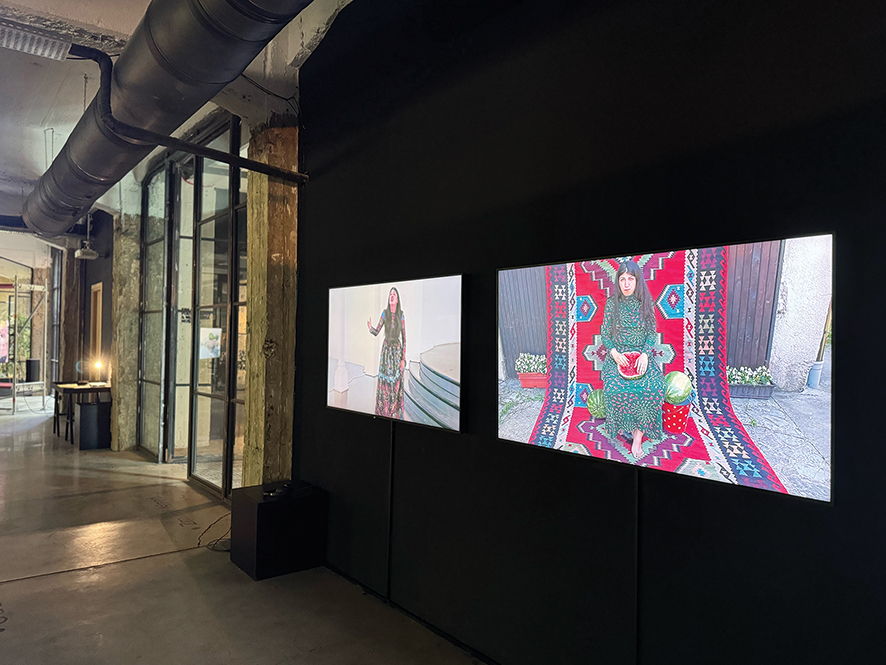
Concept, Objectives, and Themes
‘Evrovizion. Crossing Stories and Spaces’ is an innovative exhibition curated by Sabina Klemm and Sanja Kojic Mladenov, under the auspices of the Institut für Auslandsbeziehungen (ifa). This traveling exhibition delves into the contemporary social and political dynamics of Europe, particularly focusing on its less visible and marginalized geopolitical and cultural spaces. The exhibition has already visited several cities, and will continue its journey through various European locations until 2027. Each stop enriches the project with new local contributions, creating a dynamic and evolving narrative of European identity.
The primary objective of ‘Evrovizion. Crossing Stories and Spaces’ is to explore and present the nuanced and often overlooked aspects of European identity. It seeks to engage with the concept of Europe not as a monolithic entity, but as a mosaic of diverse and sometimes conflicting narratives. The exhibition features themes related to migration, historical memory, and social justice, and addresses the idea of “semi-peripheries” and “places of diversity,” focusing on regions that are frequently marginalized in mainstream cultural and political discourses.
The exhibition’s ability to adapt and incorporate local elements has made it a unique and engaging experience at each of its destinations. For instance, in Nicosia, the exhibition included new works by Greek Cypriot artist Kyriakos Theocharous and Turkish Cypriot artist Nurtane Karagil, curated by Maria Efstathiou. This local expansion not only enriched the exhibition but also sparked important conversations about identity and coexistence. The publication of the ‘Evrovizion’ magazine at each stop further documents and analyzes the impact of the exhibition. These magazines serve as an “archive of the journey,” capturing the evolving dialogue and the exhibition’s influence on the cultural identity of each host city.
When the exhibition arrived in Tbilisi, Georgia, it was enriched with the contributions of Georgian artists Nika Kutateladze and Vajiko Chachkhiani. Their works brought unique perspectives to the exhibition, reflecting the cultural and social fabric of Georgia while resonating with broader European themes.
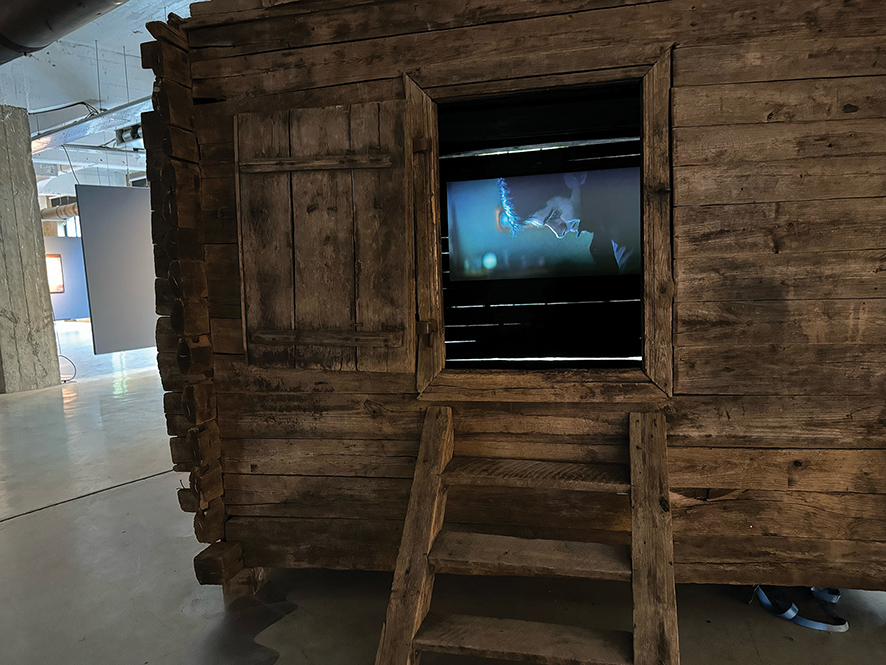
Nika Kutateladze: ‘To Protect My House While I Am Away’
Nika Kutateladze’s installation, ‘To Protect My House While I Am Away,’ serves as a poignant metaphor for the themes of home, community, and coexistence. The artwork features a large curtain adorned with thorns, making it an untouchable barrier. This transformation of a familiar domestic symbol into something hostile and unapproachable speaks volumes about the changing dynamics within communities.
Kutateladze draws inspiration from his experiences in a depopulating Georgian village, capturing the essence of human interactions in small, close-knit communities. His work delves into the fragility of these bonds, highlighting how fear and mistrust can erode the foundations of communal living. The thorn-covered curtain symbolizes a shift from mutual support to a celebration of others’ misfortunes, inviting viewers to reflect on the darker aspects of shared existence.
This piece resonates deeply within the context of ‘Evrovizion,’ as it mirrors broader European concerns about social cohesion and the impact of socio-economic changes on traditional communities. Kutateladze’s exploration of the human condition, through the lens of his local environment, offers universal insights that enhance the exhibition’s narrative on European identity.
Vajiko Chachkhiani: ‘Glass Bones’ and ‘Shivering Heart’
Vajiko Chachkhiani’s contribution to the exhibition includes the video installation ‘Glass Bones’ and the film ‘Shivering Heart,’ which are presented within a traditional Georgian wooden barn. ‘Shivering Heart’ is a modern adaptation of a Georgian folk tale about a young man named Sandro, his unrequited love for Elene, and the complexities of his relationship with his mother. This narrative explores themes of desire, love and manipulation, questioning concepts of identity, family, and belonging.
Chachkhiani’s work links Georgian traditions and mythology with contemporary psychological states and emotions. Through subtle visual poetry, he creates interfaces between the tangible reality of the outside world and the inner workings of the human psyche. His adaptation of the folk tale serves as a metaphor for the struggle between personal desires and societal expectations, a theme that is both deeply personal and universally relatable.
The inclusion of Chachkhiani’s work in ‘Evrovizion’ layers an understanding of how cultural narratives shape individual and collective identities. Chachkhiani’s art underscores the exhibition’s goal of presenting diverse and often marginalized voices within Europe, enriching the overall narrative with a distinctly Georgian lens.
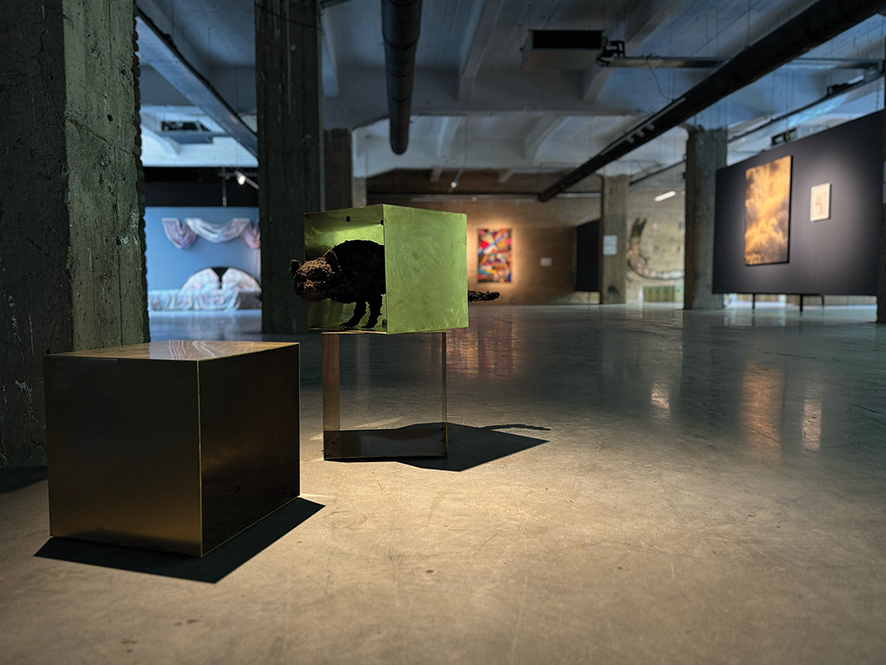
Notable works from previous regions
Selma Selman’s video performance ‘Viva La Vida’ is a powerful exploration of identity, heritage, and femininity from Bosnia and Herzegovina. In the performance, Selman sits in a frontal position with a hanging carpet in the background. She meticulously hollows out a watermelon, eating its fruit and drinking its juice, while maintaining direct eye contact with the viewer. The composition, reminiscent of a living icon, is rich in symbolism.
Petrit Halilaj’s work is deeply rooted in the history and cultural tensions of his homeland, Kosovo. His installation ‘Poisoned by Men in Need of Some Love (Felis silvestris)’ is part of a series created between 2013 and 2019. The installation features a cat sculpture made from animal excrement and earth, placed within three open brass cubes. This series was inspired by Halilaj’s rediscovery of the animal collection from the former Museum of Natural History of Kosovo, which was locked away and forgotten when the museum was transformed into the Ethnological Museum Kosovo.
Henrike Naumann’s installation ‘TRIANGULAR STORIES’ utilizes 1990s furniture and interior decor to create a room where two video works, ‘Terror’ and ‘Amnesia,’ are shown. The videos transport viewers into the lives of teenagers in 1992, capturing contrasting aspects of youth culture during that period. ‘Amnesia’ reflects the hedonistic lifestyle of the early 1990s, depicting scenes of excessive partying and drug use in Ibiza. In contrast, ‘Terror’ is set in Jena, eastern Germany, and portrays violent assaults, nationalist chants, and vandalism, reflecting the rise of far-right ideology among youth in the region. Naumann’s work explores themes of radicalization and the hedonistic drive for self-optimization, highlighting the social and political environment of the 1990s in eastern Germany.
Nevin Aladag’s works ‘Vibration III’ and ‘Percussion’ are part of her Social Fabric series, which utilizes various fragments of hand-knotted kilims, new wool and silk carpets, sisal rugs, and wool carpets. These fragments, sourced from diverse locations, are arranged in a collage, creating hybrid objects that resemble reliefs or picturesque musical compositions.
Slavs and Tatars’ ‘Pickle Bar’ is an interactive installation that blends the concept of a Slavic aperitif bar with elements of cultural and political commentary. The bar serves as a space for engaging with pickled delicacies and Slavic aperitifs in a relaxed atmosphere, encouraging visitors to explore the boundaries and possibilities of language and cultural exchange.
Lana Cmajcanin’s wallpaper installation ‘BALKANGREUEL – BALKAN CRUELTY’ juxtaposes Viennese toile de Jouy designs with motifs from Gottfried Sieben’s graphic portfolio ‘Balkangreuel,’ published in 1909. This portfolio, created during the Austro-Hungarian annexation of Bosnia, depicts acts of barbarism by Balkan soldiers, reinforcing negative stereotypes about the Balkans.
By Ivan Nechaev


